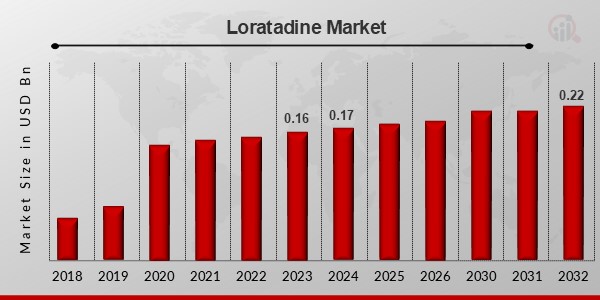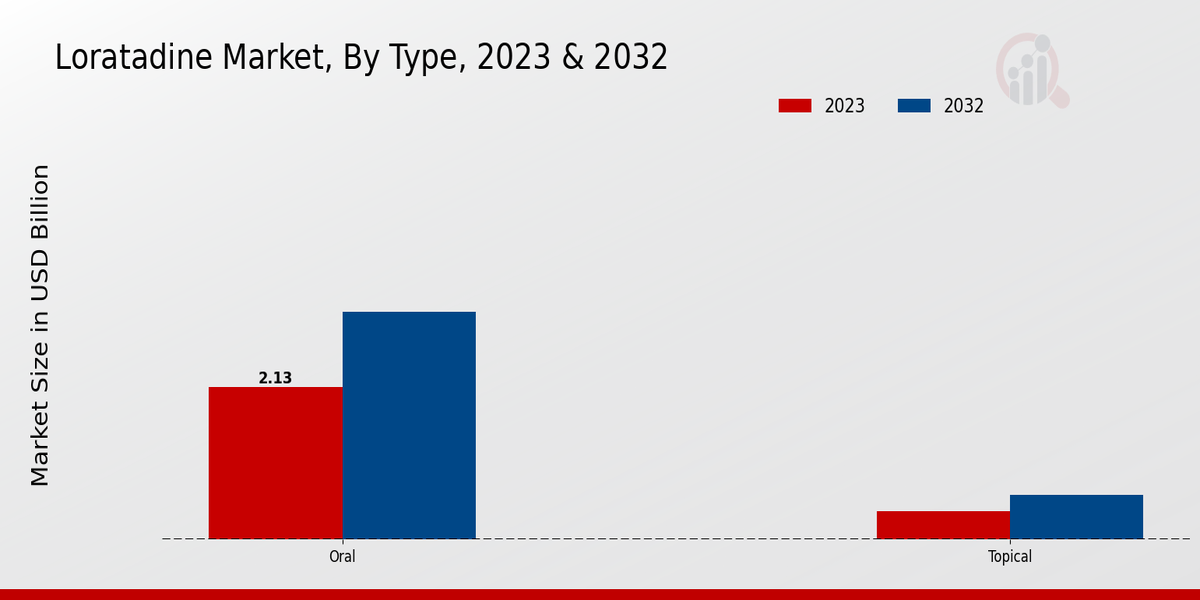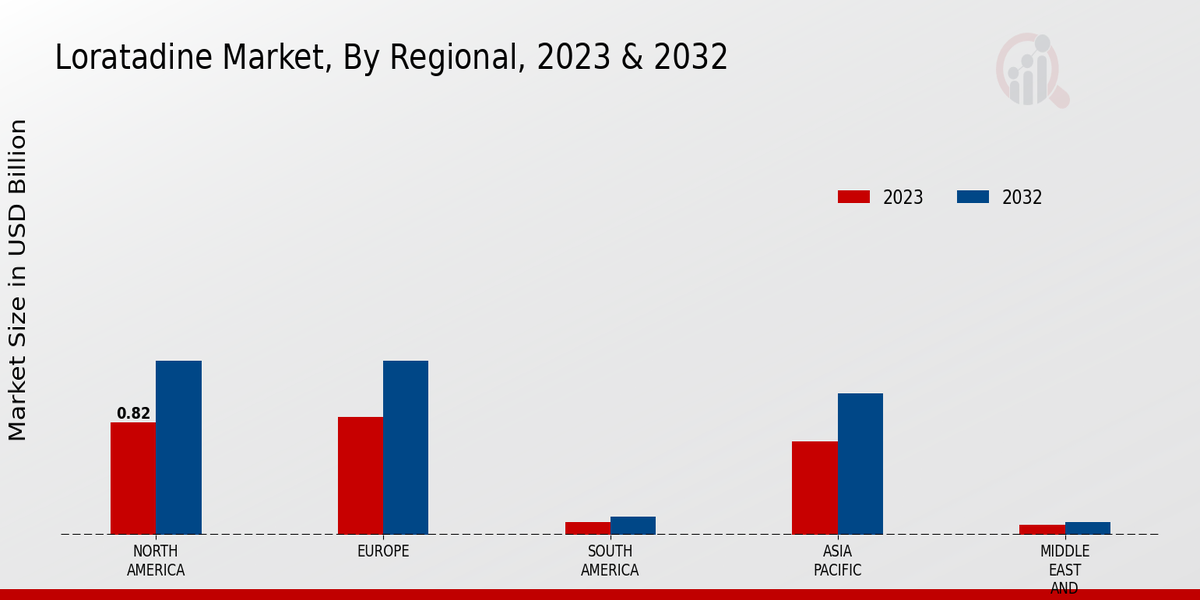Loratadine Market Overview
As per MRFR analysis, the Loratadine Market Size was estimated at 0.16 USD Billion in 2022.The Loratadine Market Industry is expected to grow from 0.17 USD Billion in 2023 to 0.22 USD Billion by 2032. The Loratadine Market CAGR (growth rate) is expected to be around 3.67% during the forecast period (2024 - 2032).
Key Loratadine Market Trends Highlighted
The global Loratadine market is primarily driven by increasing allergies and respiratory disorders. Loratadine is a second-generation antihistamine used to treat symptoms such as runny nose, sneezing, itching, and watery eyes caused by allergies or the common cold. The rising prevalence of allergic diseases, coupled with the growing population, is fueling demand for Loratadine. Additionally, the increasing popularity of over-the-counter medications is contributing to the market's growth.Opportunities exist in developing countries, where access to healthcare is expanding, and the demand for Loratadine is expected to rise.
Furthermore, the exploration of new drug delivery systems, such as nasal sprays and injectables, could offer opportunities for market expansion.Recent trends include the development of combination therapies that combine Loratadine with other medications to enhance efficacy. The use of Loratadine in combination with decongestants or pain relievers has been gaining popularity. Additionally, the trend toward personalized medicine is opening up opportunities for the development of Loratadine formulations tailored to individual patient needs.

Source: Primary Research, Secondary Research, MRFR Database and Analyst Review
Loratadine Market Drivers
Rising Prevalence of Allergic Rhinitis and Asthma
Loratadine is a second-generation antihistamine used primarily to treat allergic rhinitis or hay fever and chronic idiopathic urticaria or hives. Allergic rhinitis describes inflammation of the nasal passages and is a common condition. The cause is exposure to irritants or allergens such as pollen, pet dander, or dust. Asthma is a chronic respiratory disease that narrows and inflames the airways of the lungs, causing breathing difficulty. Increasing prevalence of these allergic diseases contributes to the growth of the Global Loratadine Market Industry.According to the World Health Organization, allergic rhinitis affects about 20% of the global population with increasing prevalence, largely accounting for urbanization, industrialization, air pollution, and lifestyle changes. Conversely, asthma affects about 1% to 18% of the population worldwide and can range to even higher percentages in developed countries. The increasing incidence of these illnesses puts a burden on the population; thus, the demand for treatments that work as fast as loratadine to alleviate these conditions continues to grow.
Increasing Healthcare Expenditure and Access to Medications
The Global Loratadine Market Industry is thriving due to rising healthcare expenditure and better access to medicines in several developing countries. Governments and healthcare regulatory bodies across the world are investing in the improvement of healthcare infrastructure and increasing access to medicines to expand their markets. This is especially necessary for low- and middle-income economies as a substantially high percentage of the population does not have access to quality healthcare.Moreover, these economies are in the phase of developing their respective healthcare systems, which is expected to increase the demand for effective and accessible medicines like loratadine. Furthermore, the development of generic and biosimilar alternatives is making loratadine more accessible to patients, also aiding the growth of the market.
Growing Awareness and Self-Medication
Increased awareness about allergic conditions and the availability of over-the-counter (OTC) antihistamines like loratadine have contributed to the growth of the Global Loratadine Market Industry. Patients are becoming more knowledgeable about their health conditions and are seeking effective treatments. The availability of OTC loratadine allows patients to self-medicate for mild allergic symptoms, which has led to increased demand for the drug. Furthermore, the convenience of OTC loratadine, which can be purchased without a prescription, makes it an attractive option for patients who want to manage their allergic symptoms quickly and effectively.
Loratadine Market Segment Insights
Loratadine Market Type Insight
The Global Loratadine Market is segmented by type into Oral and Topical. The Oral segment is expected to dominate the Loratadine Market throughout the forecast period, owing to the ease of administration and widespread availability of oral formulations. Several studies suggest the efficacy and safety of oral Loratadine in managing allergic rhinitis, urticaria, and other allergic conditions. Its non-sedating properties, lack of significant drug interactions, and relatively low cost contribute to its widespread adoption in clinical practice.
The Topical segment, on the other hand, is anticipated to witness significant growth over the coming years due to the increasing prevalence of skin allergies and the convenience of topical application.Topical Loratadine formulations are becoming increasingly popular for treating localized allergic reactions, such as eczema and contact dermatitis. The Global Loratadine Market revenue for the Oral segment is projected to reach USD 2.1 billion by 2023, exhibiting a CAGR of 4.5%.
The Topical segment is anticipated to grow at a slightly higher CAGR of 4.7%, reaching a market value of USD 0.4 billion by 2023. The growth in both segments is primarily driven by the rising prevalence of allergic diseases, increasing awareness about Loratadine's effectiveness, and the introduction of new and innovative formulations.Major market players are focusing on developing sustained-release and combination therapies to enhance patient convenience and improve treatment outcomes. These advancements are expected to further drive the growth of the Loratadine Market in the coming years.

Source: Primary Research, Secondary Research, MRFR Database and Analyst Review
Loratadine Market Dosage Form Insights
The Global Loratadine Market segmentation by dosage form includes tablets, syrups, creams, and gels. Among these, tablets hold the largest market share due to their ease of administration, cost-effectiveness, and wide availability. Tablets are preferred for long-term treatment and are commonly used for seasonal allergies. Syrups are another popular dosage form, particularly for children and individuals who have difficulty swallowing tablets. Creams and gels are topical formulations that are applied directly to the affected area, providing localized relief from itching and inflammation.The Global Loratadine Market revenue for the dosage form segment is expected to grow significantly in the coming years, driven by the increasing prevalence of allergic disorders and the growing demand for convenient and effective treatment options.
Loratadine Market Strength Insights
The Strength segment of the Global Loratadine Market is anticipated to observe considerable growth in the upcoming years, with an increasing demand for 5 mg and 10 mg dosage strengths. In 2024, the 5 mg segment is estimated to account for a significant share of the overall revenue, owing to its widespread usage in treating various allergic conditions. The 10 mg segment is also projected to witness notable growth, driven by its effectiveness in managing severe allergic reactions. The market growth is attributed to the rising prevalence of allergic disorders, such as allergic rhinitis and urticaria.Additionally, the increasing awareness about the safety and efficacy of loratadine, coupled with the convenience of once-daily dosing, is expected to contribute to the growth of this segment.
Loratadine Market Application Insights
The Global Loratadine Market is segmented based on application into Seasonal Allergic Rhinitis and Chronic Urticaria. The Seasonal Allergic Rhinitis segment held a larger market share in 2023 and is expected to continue its dominance throughout the forecast period. The growth of this segment can be attributed to the increasing prevalence of seasonal allergies and the effectiveness of loratadine in alleviating symptoms such as sneezing, runny nose, and itchy eyes. The Chronic Urticaria segment is also expected to witness significant growth during the forecast period due to the rising incidence of chronic skin conditions and the efficacy of loratadine in reducing the severity and frequency of hives.
Loratadine Market Regional Insights
The regional segmentation of the Global Loratadine Market presents distinct market dynamics and growth opportunities. North America holds a significant share, driven by the high prevalence of allergic rhinitis and the presence of major pharmaceutical companies. Europe follows closely, with a well-established healthcare system and a large patient population. The APAC region is expected to witness substantial growth due to increasing disposable income, rising awareness of allergies, and expanding healthcare infrastructure. South America and MEA are emerging markets with growing demand for Loratadine, fueled by increasing urbanization and healthcare spending.These regional insights provide valuable guidance for market players to tailor their strategies and capitalize on specific growth opportunities.

Source: Primary Research, Secondary Research, MRFR Database and Analyst Review
Loratadine Market Key Players And Competitive Insights
Major players in Loratadine Market industry are constantly engaging in research and development activities to introduce innovative products and expand their market share. Leading Loratadine Market players are focusing on strategic partnerships, acquisitions, and collaborations to strengthen their position in the market and gain access to new technologies and markets. The Loratadine Market is characterized by intense competition, with several key players vying for market dominance. These companies are investing heavily in marketing and promotional activities to increase brand visibility and attract customers.
The Loratadine Market development is also being driven by the growing adoption of advanced technologies, such as artificial intelligence (AI) and machine learning (ML), which are being used to improve product development and manufacturing processes.A leading player in the Global Loratadine Market is Claritin, a brand owned by Bayer Consumer Healthcare.
Claritin offers a range of Loratadine products, including oral tablets, chewable tablets, and syrup, and is known for its fast-acting and non-drowsy formula. The company has strong brand recognition and a loyal customer base, and it is constantly innovating to maintain its market leadership. Claritin has a global presence, with operations in over 100 countries, and it is committed to providing high-quality products and services to its customers.A competitor company in the Global Loratadine Market is Zyrtec, a brand owned by Johnson & Johnson Consumer Health.
Zyrtec offers a range of Loratadine products, including oral tablets, chewable tablets, and liquid, and is known for its 24-hour relief from allergy symptoms. The company has a strong presence in the United States and is expanding its operations in other markets. Zyrtec is focused on developing innovative products and is committed to providing effective and safe treatments for allergy sufferers.
Key Companies in the Loratadine Market Include
- Kowa
- Eisai
- Kyowa Hakko Kirin
- GSK
- Sanofi
- Johnson Johnson
- Bayer
- Boehringer Ingelheim
- Shionogi
- McNeil Consumer Healthcare
- Merck
- Astellas Pharma
- Pfizer
- Taisho Pharmaceutical
- Novartis
Loratadine Market Industry Developments
The Loratadine market is projected to reach USD 3.8 billion by 2032, exhibiting a CAGR of 4.67% during the forecast period (2024-2032). Increasing prevalence of allergic rhinitis and chronic urticaria, coupled with the rising demand for over-the-counter (OTC) medications, are the key factors driving market growth. Recent news developments include the launch of new Loratadine-based combination therapies, such as Loratadine-Montelukast and Loratadine-Pseudoephedrine, which offer enhanced efficacy and convenience for patients. Additionally, the growing adoption of telemedicine and online pharmacies is expected to fuel market growth, particularly in emerging regions.
Loratadine Market Segmentation Insights
Loratadine Market Type Outlook
Loratadine Market Dosage Form Outlook
- Tablets
- Syrups
- Creams
- Gels
Loratadine Market Strength Outlook
Loratadine Market Application Outlook
- Seasonal Allergic Rhinitis
- Chronic Urticaria
Loratadine Market Regional Outlook
- North America
- Europe
- South America
- Asia Pacific
- Middle East and Africa
| Report Attribute/Metric |
Details |
| Market Size 2023 |
0.16 (USD Billion) |
| Market Size 2024 |
0.17 (USD Billion) |
| Market Size 2032 |
0.22 (USD Billion) |
| Compound Annual Growth Rate (CAGR) |
3.67% (2024 - 2032) |
| Report Coverage |
Revenue Forecast, Competitive Landscape, Growth Factors, and Trends |
| Base Year |
2023 |
| Market Forecast Period |
2024 - 2032 |
| Historical Data |
2019 - 2023 |
| Market Forecast Units |
USD Billion |
| Key Companies Profiled |
Kowa, Eisai, Kyowa Hakko Kirin, GSK, Sanofi, Johnson Johnson, Bayer, Boehringer Ingelheim, Shionogi, McNeil Consumer Healthcare, Merck, Astellas Pharma, Pfizer, Taisho Pharmaceutical, Novartis |
| Segments Covered |
Type, Dosage Form, Strength, Application, Regional |
| Key Market Opportunities |
1 Growing Prevalence of Allergic Rhinitis and Urticaria2 Increasing OTC availability3 Rising disposable income4 Expanding Generics Market5 Drug Delivery Innovations |
| Key Market Dynamics |
Rising prevalence of allergies Increasing OTC availability Development of generic forms Growing demand for self-treatment Expansion into emerging markets |
| Countries Covered |
North America, Europe, APAC, South America, MEA |
Frequently Asked Questions (FAQ) :
The global Loratadine market is anticipated to reach an overall valuation of 0.16 billion USD in 2023.
The global Loratadine market is projected to reach an overall valuation of 0.22 billion USD in 2032.
The global Loratadine market is estimated to grow at a CAGR of 3.67% from 2024 to 2032.
North America is expected to hold the largest market share in the global Loratadine market due to the high prevalence of allergic rhinitis and other allergic conditions.
Major growth drivers of the global Loratadine market include increasing prevalence of allergic diseases, rising demand for over-the-counter antihistamines, and growing awareness about the safety and efficacy of Loratadine.
Key competitors in the global Loratadine market include Bayer, Sanofi, Glenmark Pharmaceuticals, and Cipla.
Loratadine is primarily used to treat allergic rhinitis, also known as hay fever and other allergic conditions such as hives (urticaria) and angioedema.
The COVID-19 pandemic is anticipated to have a positive impact on the global Loratadine market as it has led to increased demand for over-the-counter antihistamines due to the overlapping symptoms between COVID-19 and allergies.
The global Loratadine market faces challenges such as the availability of generic alternatives, regulatory changes, and increasing competition from newer antihistamines.
Growth opportunities in the global Loratadine market include the development of combination therapies, expansion into emerging markets, and the introduction of new formulations and delivery systems.

















